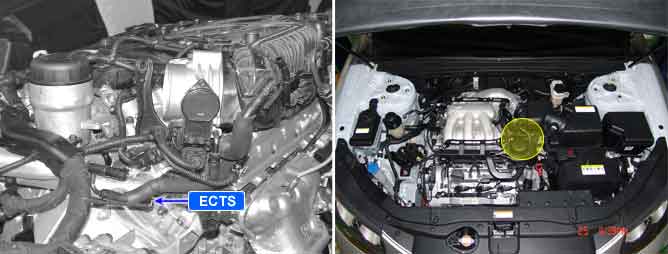

The Engine Coolant Temperature Sensor (ECTS) is located in the engine coolant passage of the cylinder head for detecting the engine coolant temperature. The ECTS uses a thermistor whose resistance changes with the temperature. The electrical resistance of the ECTS decreases as the temperature increases, and increases as the temperature decreases. The reference 5 V in the PCM is supplied to the ECTS via a resistor in the PCM. That is, the resistor in the PCM and the thermistor in the ECTS are connected in series. When the resistance value of the thermistor in the ECTS changes according to the engine coolant temperature, the output voltage also changes. During cold engine operation the PCM increases the fuel injection duration and controls the ignition timing using the information of engine coolant temperature to avoid engine stalling and improve drivability.
Checking the coolant temperature under detecting condition, if the coolant temperature exceeds the threshold temperature under normal operation loads, PCM sets P0217.
Item | Detecting Condition | Possible cause |
DTC Strategy | ● Monitor the coolant temperature | ● ECTS |
Enable Conditions | ● Coolant sensor is normal ● No disabling faults present(DTCs related to MAFS/MAPS, catalyst, fuel system or engine oil temperature sensor) ● Coolant Temperature at startup < 45℃( 113 °F) ● Engine running state ● Coolant temperature > 50℃( 122 °F) ● Intake air temperature < 35℃( 95 °F) | |
Thresh old value | ● Coolant temperature ≥ 110℃ (230 °F)(Average airflow< 30 g/sec and filtered airflow< 50 g/sec) | |
Diagnosis Time | ● Once per driving cycle ( about 2 minutes) | |
MIL On Condition | ● No MIL ON (DTC only) |